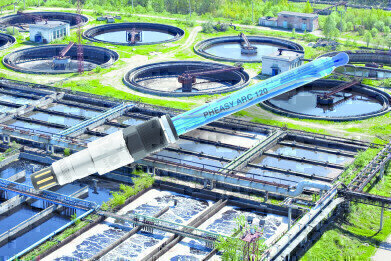Water/Wastewater
Maximum Process Safety with Minimum Maintenance Cost with Sensors in Waste Water Treatment
Jul 11 2013
Ordinary pH sensors used in deammonification are costly to maintain and offer limited process safety considerations. Hamilton (Switzerland), specialist sensor technology manufacturer, has developed an efficient alternative with pHeasy Arc 120.
An important step in the treatment of highly contaminated waste water is nitrogen elimination. The deammonification process, the cost-effective alternative to nitrification/denitrification, is regarded as an innovative nitrogen elimination process with high potential. The measurement of ammonia and nitrous acid values are important to determine the process efficiency, and a conversion ratio can be calculated from the analytical values of nitrite (NO2- ) and ammonium (NH4+ ) with the help of pH.
The measurement of pH is traditionally extremely difficult in the deammonification process because the use is very costly under current technical requirements: Since the substances contained in the process water can have a negative impact on the pH electrode’s reference, the sensors are regularly recalibrated for safety reasons. Even this high maintenance expense, however, guarantees only limited process safety because new interferences can occur until the time that the next measurement is made. The prerequisite for maximum process safety would therefore be continuous electrolyte control, but this cannot be conducted with conventional sensors.
Hamilton has developed a pH sensor that guarantees continuous electrolyte control with pHeasy Arc 120., By integrating CheckRef, a second reference check that monitors the status of the reference electrolytes is conducted. When the threshold value of the maximum permissible potential difference is set at the start, an alarm signal indicates the calibration need and the measuring capability and quality is permanently monitored. Process errors caused by unrecognisable interferences of the pH electrolyte are ruled out. Thanks to an extremely stable reference derivation and the patented Polysolve electrolyte, a permanently high reference quality is also ensured.
A long-term study carried out by the Hanover Institute for Urban Water Management and Waste Disposal Technology (ISAH) has impressively proven the efficiency of Hamilton’s pHeasy Arc 120. Used in a reactor with process water from sludge dewatering, it gave stable and accurate measurement values for about ten months. Only afterwards did the reference quality of the electrolyte diminish and the sensor reliably indicated when the threshold value set at the start was exceeded.
In addition to increased process safety, pHeasy Arc 120 users also benefit from the general advantages offered by the Arc Sensor System that Hamilton has developed: By integrating the transmitter in the sensor’s head, no measurment amplifier is needed. The sensor thus communicates directly with the process control system, optionally through an analog standard (4-20 mA) or digital modbus interface (RS 485). Moreover, Arc sensors provide a full overview of sensor quality, operational life, warnings or error messages and a lot of additional information needed for the logbooks of the measuring points.
Digital Edition
IET 34.2 March 2024
April 2024
Gas Detection - Biogas batch fermentation system for laboratory use with automatic gas analysis in real time Water/Wastewater - Upcycling sensors for sustainable nature management - Prist...
View all digital editions
Events
Apr 22 2024 Hannover, Germany
Apr 22 2024 Marrakech, Morroco
Apr 23 2024 Kuala Lumpur, Malaysia
Apr 23 2024 Kintex, South Korea
Apr 23 2024 Edmonton, AB, Canada


















